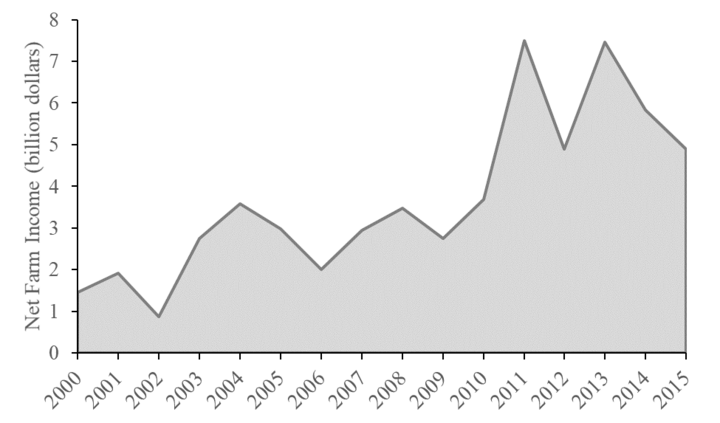
The following Cornhusker Economics article was written by Kate Brooks, Cory Walters, Jay Parsons, Andrea Ramirez, Larry Van Tassell, Brad Lubben, and Dave Aiken in the Department of Agricultural Economics.
Significant financial changes have been underway in the U.S. agricultural system. After a decade of increases in crop and livestock prices mirrored by corresponding increases in expenses, prices began declining dramatically in 2014 (USDA-NASS, 2017). Figure 1 shows yearly net farm income for Nebraska crop and livestock producers from 2000 to 2015 (USDA, ERS). A survey in July 2016 indicated that 52 percent of Nebraska farmers and ranchers were financially stressed.
Because producers are unique in their production costs, yields, prices, capital allocation, location, etc., identifying the demographic and financial characteristics that are contributing to financial stress is important to gain a deeper understanding of the problem. With this in mind, a survey of Nebraska agricultural crop and livestock producers was conducted in the summer of 2016 with the overall goal of evaluating financial stress. While identifying stress is useful, identifying actions producers intend to take to help ensure farm survival is equally important. Using the same demographic and financial characteristics used in the stress model, we evaluate the characteristics contributing to producers: 1) focusing on increasing revenue and/or 2) lowering costs. Models were used to determine variables that impacted the likelihood a producer was financially stressed as well as how they were planning to react to it.
A total of 1,000 surveys were returned with a total of 758 thoroughly completed and used in the analysis.
Continue Reading this January 24, 2018 Cornhusker Economics to see what producers said about how they were addressing financial concerns — reducing costs or increasing income — and factors affecting their response to financial stress.

